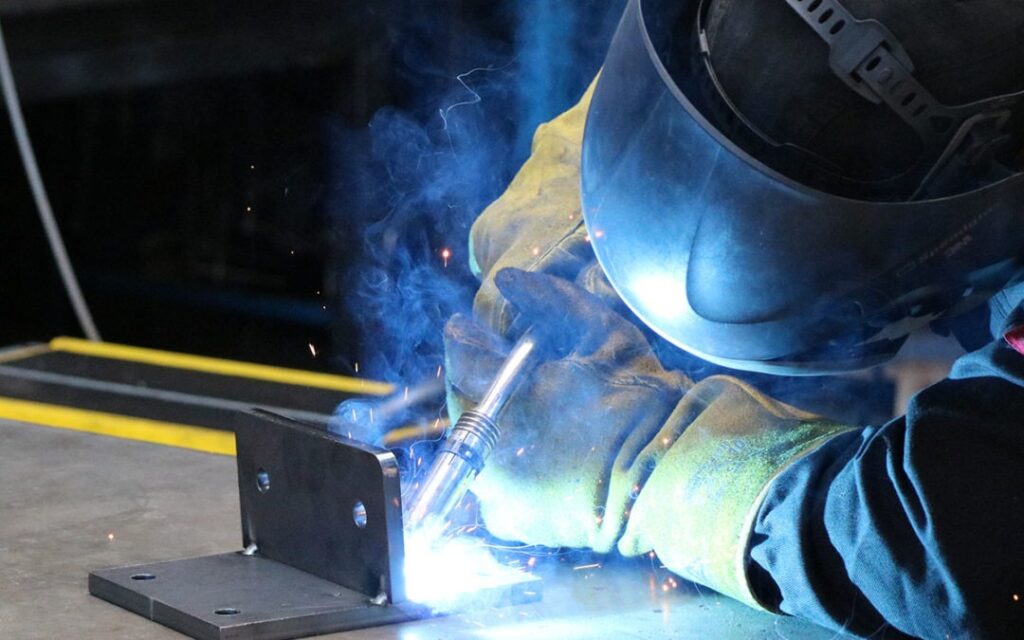The sheet metal work plays a significant role in welding. It involves a combination of two or more metal pieces through the use of heat or pressure. Welding has to be neat, strong, and precise in sheet metal fabrication. The sheet metal is generally no more than 6 mm thick; thus, special consideration must be taken to prevent warping or burn-through.
This article tells about the typical types of welding in sheet metal. You will also know in which combination of each type is effective and more.
How Does Welding Help in Sheet Metal?
Sheet metal is used in car parts, kitchen equipment, ducts, and machines. These parts are joined using welding, but no screws/ bolts. Good welding brings:
- Strong joints
- Smooth finish
- Long-term performance
- Clean appearance
However, thin sheets may melt quickly. Therefore, the proper approach has to be adopted.
1. Metal Inert Gas (MIG) Welding
Other names associated with MIG welding are Gas Metal Arc Welding (GMAW). It involves a wire that is fed into a gun that melts into the metal. A weld is guarded by a shielding gas, which protects the weld against air.
It is used where:
Car repair
Furniture
HVAC ducts
Benefits:
Quicker and convenient
Smooth and clean welds
Does not work well on thin sheets
Limitations:
Not fit for outdoor labour
Requires gas and a clear surface
2. Tungsten Inert Gas Welding (TIG)
This type of welding, which is also referred to as Gas Tungsten Arc Welding (GTAW), is TIG welding. It provides the arc, making use of a tungsten electrode. Hand application of filler metal is done.
Its Usage:
Aircraft
Containers food grade
Artistic metalwork
Benefits:
Really neat and powerful welds
Superb thin metal
No smokes or sprays
Limitations:
Beneath the speed of MIG
Requires more ability
3. Resistance Spot Welding (Spot Welding)
Resistance welding includes spot welding. It causes a passage of electric current between two metal sheets, heating them at the point of contact. A weld is created by then applying pressure.
Where it’s employed:
Auto body panels
Boxes made of sheet metal
Home appliances
Benefits:
Fast and simple
No gas or filler required
It is good for bulk work.
Limitations:
Works on joints on the joints which overlap
Not in heavy metals
4. Laser Welding
Laser welding involves welding of metals with the assistance of a focused laser beam. It forms a thin and deep weld, and the heat spread is minimal.
In Which It is Applied:
Electronics
Medical devices
Precision parts
Benefits:
High speed
Crisp clean welds
Low heat deformity
Limitations:
Expensive setup
Requires perfection in needs. According to the argument of this article, one says that needs require perfection because the only way they can be successful is when they are perfectly aligned.
5. Plasma Arc Welding
Plasma arc welding resembles TIG, where it replaces the use of the gas with the plasma gas that is easier to control. It forms a small and narrow hot arc.
Application:
Aerospace
Tool making
Sheet metal work high-end
Benefits:
Better and tidier welds
Coarse manipulation on thin metals
Limitations:
Costly equipment
Requires a skilful operator
6. Making Oxy-Acetylene Welding
It is a gas welding technique in which oxygen and acetylene are burned and provide a flame. Some sheet metal work is done with it.
Where is it used?
Repair shops
Tailor-made metal work.
Benefits:
There is no requirement for electricity
Mobile and basic
Limitations:
Lumbering and antique
Not as accurate as TIG or MIG
What to Do When Selecting a Welding Type
- Metal thickness- Thin sheets require close control.
- Consider the type of joints. It would not be the same type of welds on overlap or edge joints.
- Consider speed, MIG is faster than TIG.
- Warp or distort- Laser or TIG will produce less distortion.
- Cost factor: MIG is lower priced in comparison to laser or plasma.
- Make a choice indoors or outdoors – MIG and TIG use shielding gas.
- See volume of production – Spot welding is well suited to mass production.
Several companies, like a precision sheet metal fabrication company, offer premium fabrication.
Conclusion:
MIG Welding – Super chill if you just wanna get the job done quick and not stress too much. Plug it in, pull the trigger, boom—metal’s stuck together.
TIG Welding – Now, this one’s for the perfectionists and people who love a good challenge. You get crisp, clean seams, but man, does it take patience (and a steady hand).
Spot Welding – Straight-up assembly line MVP. Factories love this stuff because it’s fast and repeatable. Not exactly “artsy,” but hey, it works.
Laser Welding – Fancy and not cheap. This is what you use when you’re dealing with tiny, expensive parts and don’t want to mess anything up. Feels a bit sci-fi, honestly.
Oxy-Acetylene – Old school, but still kicking. Great if you’re out in the wild and need something portable. Doesn’t need a fancy setup. Just fire and go.
Bottom line?
Welding sheet metal isn’t for the reckless. Thin stuff warps or burns if you sneeze at it wrong, so you gotta pick the right tool for the job. MIG, TIG, spot—these are the big players. Each one’s got its quirks, and what you pick depends on what you’re working with, how much cash you’ve got, and whether you know what you’re doing.
Long story short: Don’t wing it. Pick the right method so your project doesn’t end up looking like a melted soda can. Clean welds, strong joints, no disasters—that’s the dream, right?


